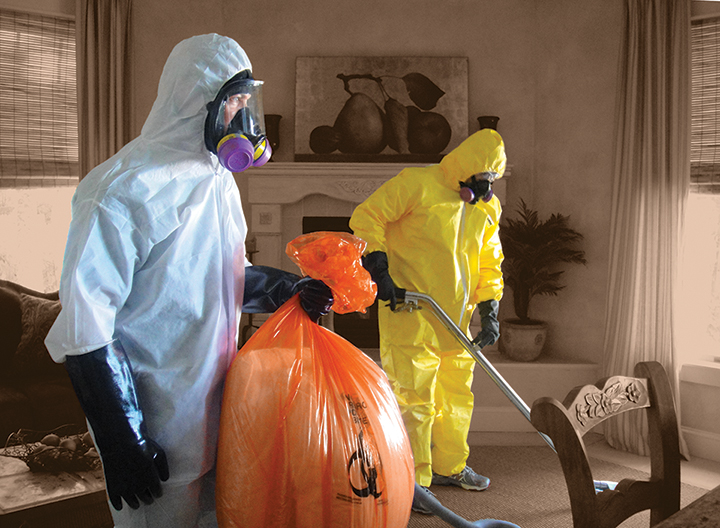Hoarder Cleanup Solutions: Restoring Order and Safety in Your Home
Hoarder Cleanup Solutions: Restoring Order and Safety in Your Home
Blog Article
Professional Biohazard Cleansing and Decontamination for Blood, Bodily Fluids, and Hazardous Products
The possible health and wellness dangers linked with direct exposure to biohazards highlight the critical demand for careful handling and comprehensive clean-up. As we browse the intricate landscape of biohazard cleaning, comprehending the subtleties of guidelines, conformity, and the specific devices at play ends up being crucial in ensuring a comprehensive and risk-free purification procedure.
Health Risks of Biohazard Direct Exposure
Direct exposure to biohazards poses substantial wellness risks that can cause extreme consequences for individuals and communities alike. Biohazards incorporate a wide variety of organic compounds, including blood, bodily liquids, mold and mildew, germs, infections, and other potentially transmittable materials. When people enter contact with these biohazards, whether through accidents, improper handling, or environmental exposure, they face the risk of contracting serious diseases or diseases.
One of the primary health threats linked with biohazard direct exposure is the transmission of transmittable conditions. Bloodborne microorganisms such as HIV, hepatitis B and C, and different germs can be present in biohazardous materials, posing a straight hazard to human wellness. Breathing in airborne biohazards like mold spores or entering into call with polluted surfaces can also lead to respiratory concerns, allergic reactions, and other unfavorable health results.
Moreover, biohazard exposure can have long-term wellness ramifications, with some illness manifesting years after the first call (Blood Cleanup). Therefore, it is crucial to focus on appropriate biohazard cleaning and decontamination to minimize these wellness threats and make sure the security of individuals and areas

Specialized Training for Biohazard Cleaning
When it concerns taking care of biohazard clean-up successfully and securely, specialized training plays an essential duty in guaranteeing appropriate purification procedures are adhered to. Biohazard cleaning requires certain expertise and skills to efficiently minimize threats connected with bloodborne microorganisms, physical fluids, and dangerous products. Specialists learnt biohazard clean-up go through strenuous instruction on exactly how to safely take care of, get rid of, and deal with biohazardous materials to avoid contamination and exposure.
Specialized training for biohazard cleanup covers an array of essential topics, consisting of proper personal protective equipment (PPE) use, bloodborne pathogen awareness, decontamination techniques, and dangerous waste disposal protocols. Individuals learnt biohazard cleanup are equipped with the necessary competence to examine contamination degrees, determine potential risks, and implement appropriate cleanup treatments in conformity with regulative requirements.
Continuous training and education are extremely important in the area of biohazard clean-up to stay updated on the current purification innovations, security protocols, and regulations. By purchasing specialized training, biohazard clean-up professionals can effectively react to emergency situation cleanup scenarios and guard both public health and wellness and the environment.
Relevance of Appropriate Decontamination Methods
Using proper purification methods is essential in biohazard cleanup to successfully get rid of hazardous products and minimize health threats. Effective purification not only makes certain the removal of noticeable traces of blood, bodily liquids, and other biohazards however also targets undetectable pathogens that might position significant health and wellness hazards if not properly removed. By following rigorous decontamination methods, trained specialists can considerably lower the risk of direct exposure to harmful microbes, viruses, and germs that can result in illness or infections.
Correct decontamination strategies involve the use of specific tools and disinfectants that are particularly designed to reduce the effects of biohazards properly. Extensive cleansing and sanitation of contaminated areas are vital to protect against the spread of pathogens and make sure a secure setting for occupants. Furthermore, the right disposal of biohazardous waste adhering to decontamination procedures is crucial in preventing contamination of other surfaces or individuals.

Tools and Devices for Safe Clean-up
The proper equipment and devices play a critical duty in making sure the reliable and risk-free clean-up of biohazardous materials. When dealing with blood, physical liquids, or dangerous products, biohazard cleansing professionals count on specialized equipment to reduce exposure threats and completely decontaminate the damaged area. Personal safety equipment (PPE) clean up blood/body fluids such as handwear covers, safety glasses, masks, and coveralls are vital to safeguard against direct call with potentially transmittable products. Additionally, biohazard cleansing kits having anti-bacterials, absorbent products, and biohazard bags are used to securely include and get rid of of polluted items. Blood Cleanup.
Advanced cleansing tools like hospital-grade disinfectants, HEPA-filtered vacuum cleaners, and misting machines are utilized to sterilize surface areas and remove biohazards efficiently. Specialized tools such as sharps containers and biohazard garbage disposal containers crime scene cleanup employment are utilized to safely handle sharp items and biohazardous waste products. By making use of the right devices and tools, biohazard cleansing specialists can make certain a comprehensive clean-up procedure that focuses on safety and security and decreases wellness risks for both workers and occupants of the affected area.
Rules and Compliance in Biohazard Cleaning
Appropriate adherence to guidelines and conformity requirements is vital in biohazard cleansing to make certain the safety and security of both employees and the setting. Federal government companies such as OSHA (Occupational Security and Health And Wellness Administration) and the EPA (Epa) have established specific standards for biohazard cleaning treatments to lessen health and wellness dangers and environmental contamination. These regulations cover a series of facets consisting of the handling, transportation, and disposal of biohazardous materials, as well as the over at this website essential training and safety devices required for personnel entailed in the clean-up process.
Biohazard cleaning firms need to stay up-to-date with these laws to assure that their operations meet the called for safety and security requirements. Failure to abide with these guidelines can result in extreme repercussions, including penalties, legal action, and jeopardizing the health and wellness of individuals and the atmosphere. By following rigorous guidelines and compliance actions, biohazard cleaning companies can successfully reduce threats and make sure a extensive and safe cleaning process for all events included.
Verdict
To conclude, biohazard cleaning and decontamination call for specific training, correct methods, and adherence to laws. Exposure to blood, physical liquids, and dangerous products positions substantial health dangers, making it essential to make use of the right devices and devices for safe clean-up. By adhering to strict procedures and standards, professionals can efficiently alleviate the threats related to biohazard exposure and make certain the safety of both themselves and others.
As we navigate the complex landscape of biohazard cleanup, comprehending the subtleties of laws, compliance, and the customized tools at play ends up being important in making sure a detailed and safe decontamination process. (Blood Cleanup)
When it comes to taking care of biohazard cleanup efficiently and safely, specialized training plays an essential duty in making certain correct purification procedures are followed.Using correct purification strategies is crucial in biohazard clean-up to successfully minimize and remove dangerous materials wellness risks. In addition, biohazard cleaning packages including disinfectants, absorbing materials, and biohazard bags are used to safely get rid of and consist of of polluted products.
Government firms such as OSHA (Occupational Safety And Security and Health And Wellness Administration) and the EPA (Environmental Protection Firm) have actually established specific standards for biohazard clean-up procedures to minimize wellness dangers and environmental contamination.
Report this page